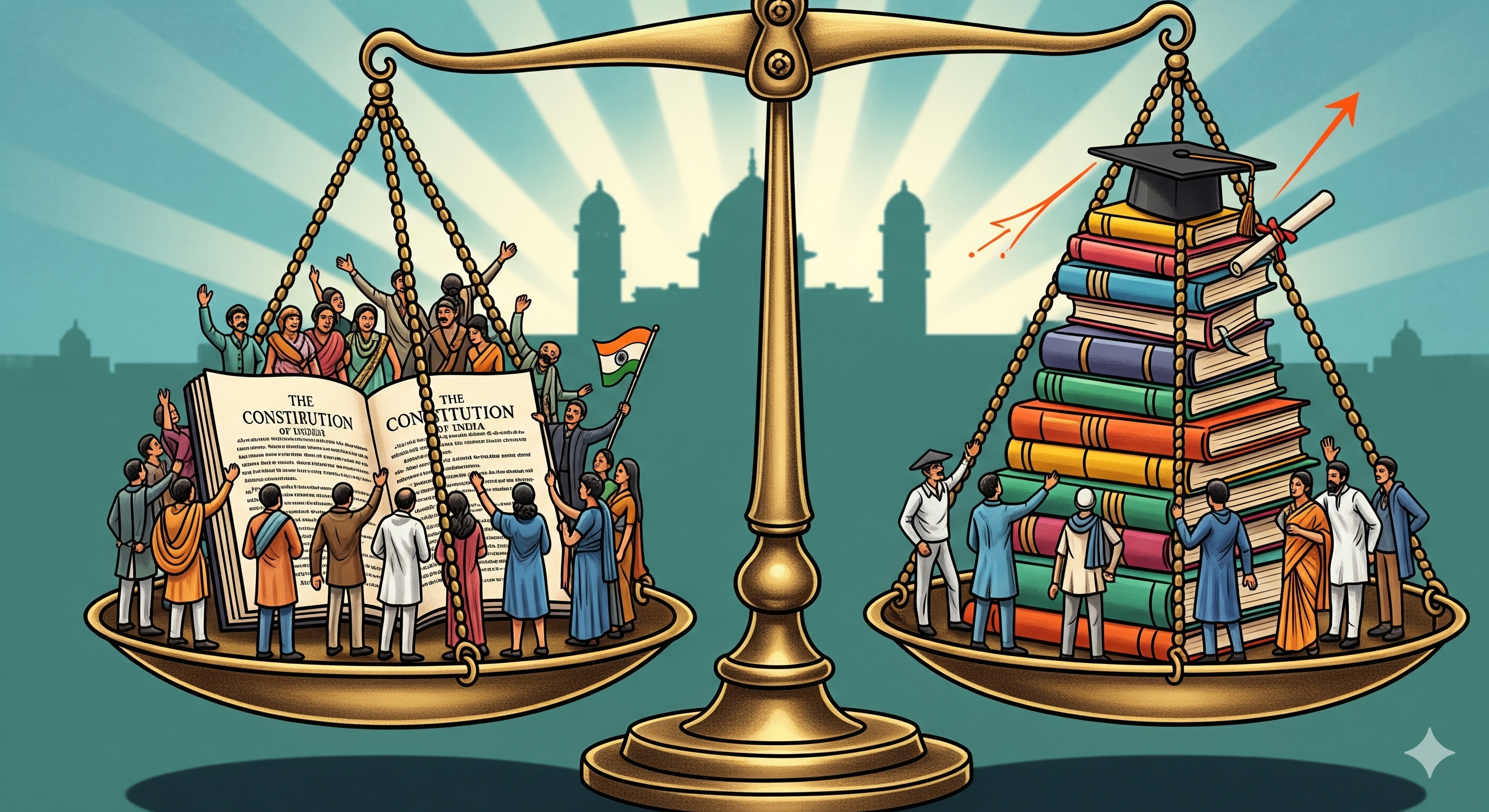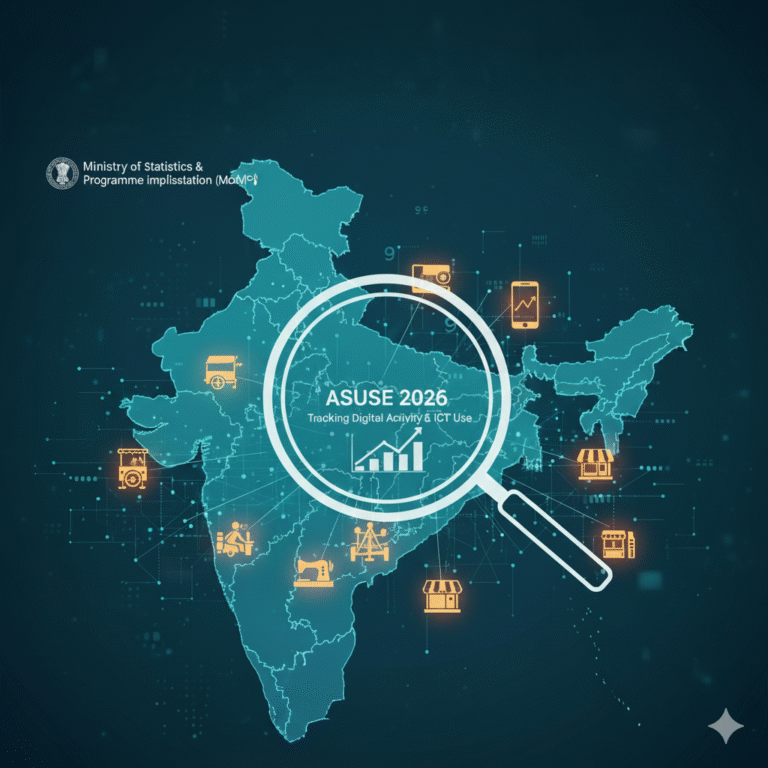Key Highlights
- Constitutional Foundation: Articles 15(4), 15(5), and 16(4) enable special provisions for SC/ST/OBC advancement, while Article 46 mandates state protection of weaker sections from social injustice
- 50% Reservation Cap: Indra Sawhney (1992) established the 50% ceiling and introduced “creamy layer” exclusion for economically advanced OBC members, currently set at ₹8 lakh annual income
- 103rd Amendment Impact: EWS quota adds 10% reservation for economically weaker sections, validated by Supreme Court’s 3:2 verdict (2022), pushing total reservation to 59.5% in central institutions
- Merit vs Equity Tension: Critics argue reservation undermines meritocracy and perpetuates caste identities, while supporters emphasize substantive equality over formal equality for historically marginalized communities
- Evolving Jurisprudence: Recent Supreme Court ruling (2024) extends creamy layer concept to SC/ST categories, indicating judicial evolution toward refined targeting of affirmative action benefits
Constitutional Framework: The Foundation of Affirmative Action
India’s reservation system rests on robust constitutional provisions designed to address historical injustices and promote substantive equality. The constitutional framework establishes a comprehensive approach to affirmative action, balancing individual rights with collective social justice.
Article 15(4) permits the state to make special provisions for advancement of socially and educationally backward classes including Scheduled Castes and Scheduled Tribes. This provision, originally absent from the Constitution, was added through the First Amendment (1951) following the State of Madras v. Champakam Dorairajan case.
Article 16(4) allows reservation in appointments for backward classes inadequately represented in state services. The 77th Amendment (1995) further added Article 16(4A) enabling reservation in promotions, while the 81st Amendment (2000) introduced Article 16(4B) for carry-forward of unfilled reserved vacancies. reflections
Article 46, a Directive Principle, mandates the state to “promote with special care the educational and economic interests of weaker sections” and protect them from social injustice and all forms of exploitation. This provision creates a moral and political obligation for governmental action toward social upliftment.
The 103rd Amendment (2019) added Articles 15(6) and 16(6), introducing 10% reservation for Economically Weaker Sections (EWS) with annual income below ₹8 lakh and specific asset criteria. This amendment represents the most significant expansion of reservation policy since independence.
Landmark Judicial Interpretations
The Indra Sawhney Revolution (1992)
The Indra Sawhney v. Union of India case fundamentally shaped India’s reservation landscape through landmark principles that continue to guide policy today. The nine-judge bench delivered a 6:3 majority verdict with far-reaching implications.
Key judicial pronouncements include:
50% Ceiling: The court established that total reservations should not exceed 50% except in extraordinary circumstances, ensuring balance between affirmative action and merit-based selection.
Creamy Layer Exclusion: Advanced sections among OBCs earning above prescribed income limits (initially ₹1 lakh, now ₹8 lakh) are excluded from reservation benefits to ensure genuine beneficiaries receive assistance.
No Reservation in Promotions: The court initially ruled against reservation in promotions, though subsequent constitutional amendments have modified this position.
Backward Classes Identification: The judgment upheld caste as a legitimate indicator of social and educational backwardness while emphasizing the need for periodic review of backward class lists.
Statutory Review Body: The court mandated establishment of a permanent body to examine over-inclusion and under-inclusion in OBC lists, leading to the National Commission for Backward Classes.
EWS Reservation Validation (2022)
The Janhit Abhiyan v. Union of India case tested the constitutional validity of economic criteria for reservations. The 5-judge Constitution bench delivered a 3:2 split verdict upholding the 103rd Amendment. lawjournal
Majority Opinion (Justices Maheshwari, Trivedi, Pardiwala):
- Economic backwardness constitutes valid criteria for affirmative action
- EWS exclusion of SC/ST/OBC categories is constitutionally permissible
- Breach of 50% cap acceptable for economic reservations
Minority Dissent (Chief Justice Lalit, Justice Bhat):
- Exclusion of marginalized communities violates constitutional equality
- Exceeding 50% limit threatens basic structure of Constitution
- Economic criteria alone insufficient without social backwardness

The Merit Versus Equality Discourse
Arguments Against Reservation
Meritocracy Concerns: Critics argue that reservation compromises merit-based selection, potentially reducing institutional quality and administrative efficiency. The concern centers on differential cut-off marks and relaxed standards for reserved categories.
Reverse Discrimination: The system allegedly creates new inequalities by disadvantaging general category candidates who may score higher but lose opportunities due to quota constraints. This raises questions about fairness and proportional representation.
Perpetuation of Caste Identity: Critics contend that reservation reinforces caste consciousness rather than promoting a caste-free society, potentially deepening social divisions. The caste-based categorization may institutionalize rather than eliminate caste distinctions.
Creamy Layer Appropriation: Economically advanced members within reserved categories allegedly monopolize benefits, preventing genuine upliftment of the most disadvantaged. This elite capture dilutes the intended impact of affirmative action.
Arguments Supporting Reservation
Historical Justice: Reservation addresses centuries of systemic discrimination and social exclusion, providing compensatory justice for past wrongs. The system recognizes that formal equality alone cannot remedy historical disadvantages.
Substantive Equality: Proponents argue for equality of outcome rather than merely equality of opportunity, recognizing that social conditions shape individual capabilities. Level playing field requires affirmative intervention.
Representation and Diversity: Reservation ensures proportional representation of marginalized communities in decision-making bodies, bringing diverse perspectives to governance and institutional leadership.
Breaking Generational Poverty: Educational and employment reservations enable social mobility, breaking intergenerational cycles of poverty and exclusion among historically marginalized groups.
Contemporary Challenges and Reforms
Creamy Layer Evolution
The current ₹8 lakh income limit for OBC creamy layer has remained unchanged since 2017, prompting calls for periodic revision. A Parliamentary Committee recommended updating the threshold, citing inflation and rising income levels.
Recent developments include:
- Supreme Court ruling (2024) extending creamy layer concept to SC/ST categories
- Parliamentary discussions on PSU salary exclusions from income calculations
- State-level variations in creamy layer implementation
Expanding Scope and Sectoral Coverage
Private Sector Reservations: Debates continue regarding reservation extension to private educational institutions and corporate employment, raising questions about constitutional limits and economic impact.
Sub-categorization: Growing demands for sub-classification within SC/ST/OBC categories to ensure equitable distribution of benefits among diverse sub-groups with varying disadvantage levels.
Economic Criteria Integration: The EWS quota represents a paradigm shift toward economic indicators, potentially influencing future reservation frameworks across all categories.
Regional Variations and Policy Innovations
State-Level Implementations
Tamil Nadu Model: The state maintains 69% total reservation, exceeding the 50% cap through special constitutional provisions and historical circumstances. This demonstrates federal flexibility in reservation implementation.
Maharashtra Initiatives: Recent reforms in medical admission procedures for OBC candidates showcase technological integration and transparency improvements in reservation administration.
Local Body Reservations: Panchayati Raj and Municipal reservations under Articles 243D and 243T extend political representation to grassroots governance, ensuring participatory democracy.
Administrative Mechanisms
Verification Systems: States are implementing digital verification of income certificates and caste credentials to prevent fraud and ensure genuine beneficiaries receive reservation benefits.
Review Mechanisms: Periodic surveys and commission reports assess reservation effectiveness and recommend policy adjustments based on changing social conditions.
Global Perspectives and Comparative Analysis
International Affirmative Action Models
United States: Race-based affirmative action in higher education faces constitutional challenges, with recent Supreme Court decisions limiting race-conscious admissions. This contrasts with India’s constitutional mandate for caste-based reservations.
Malaysia: The Bumiputera policy provides ethnic Malay preferences in education and employment, demonstrating alternative approaches to affirmative action based on ethnic identity rather than caste.
South Africa: Black Economic Empowerment policies address apartheid legacies through economic affirmative action, offering insights for India’s private sector reservation debates.
Lessons and Adaptations
Merit Redefinition: International experiences suggest that merit concepts can evolve to include diversity, representation, and social contribution alongside traditional academic criteria.
Sunset Clauses: Some countries implement time-bound affirmative action with periodic review mechanisms, ensuring policy relevance and preventing perpetual dependency.
Future Directions and Policy Recommendations
Constitutional Review and Reform
Comprehensive Assessment: Regular constitutional review of reservation policies could ensure continued relevance while addressing contemporary challenges and social changes.
Criteria Refinement: Multi-dimensional indices incorporating social, educational, and economic factors might provide more nuanced targeting than single-criterion approaches.
Technology Integration
Digital Platforms: AI-powered systems could enhance transparency, reduce fraud, and improve targeting of reservation benefits to genuine beneficiaries.
Data Analytics: Big data analysis of reservation outcomes could inform policy refinements and impact assessments for evidence-based decision-making.
Institutional Mechanisms
Independent Review Bodies: Autonomous institutions with diverse representation could conduct periodic assessments of reservation effectiveness and recommend policy modifications.
Grievance Redressal: Robust complaint mechanisms could address implementation gaps and ensure fair administration of reservation policies.
Conclusion
India’s reservation system represents a complex constitutional experiment in social engineering, attempting to balance historical justice with contemporary merit concerns. The constitutional framework provides solid legal foundation, while judicial interpretations have evolved to refine implementation and ensure targeted benefits.
The ongoing debate between merit and equality reflects fundamental tensions in democratic societies seeking to address systemic inequalities while maintaining fairness and efficiency. Recent developments, including the EWS quota and evolving jurisprudence on creamy layer exclusions, demonstrate the dynamic nature of affirmative action policy.
Future success depends on continuous adaptation to changing social conditions, technological integration for improved targeting, and evidence-based policy refinements that maximize benefits while minimizing unintended consequences. The constitutional promise of social justice requires ongoing commitment to both equity and excellence.
As India moves toward its centenary of independence, the reservation system must evolve to meet contemporary challenges while honoring constitutional principles and ensuring sustainable development for all citizens. The delicate balance between affirmative action and merit-based selection will continue to shape national discourse and policy formulation.
🔹 Mains Questions:
- Critically examine the role of the Constitution in balancing equality and social justice through reservations in India.
- Discuss the effectiveness of reservation policy as a tool for social transformation. Should India consider a shift to economic-based affirmative action?









+ There are no comments
Add yours